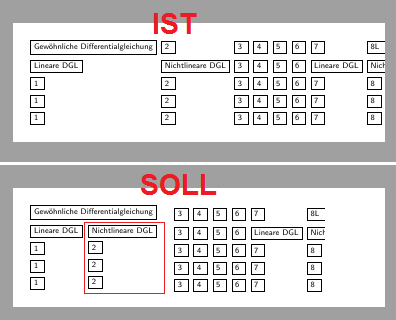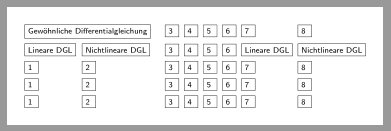|
Ich wollte die Methode aus wie-kann-ich-den-spaltenabstand-in-einer-tikz-matrix-zeilenweise-andern anwenden. Was muss ich machen, dass der \documentclass[varwidth, margin=5mm]{standalone} %\documentclass[a4paper]{article} \usepackage[ngerman]{babel} \usepackage[utf8]{inputenc} \usepackage[T1]{fontenc} \usepackage{amsmath, relsize, tikz} \usetikzlibrary{matrix} \begin{document} \begin{tikzpicture}[%scale=0.5, transform shape, -latex,font=\sffamily\footnotesize, ] \def\gDGL{Gewöhnliche Differentialgleichung} \def\lDGL{Lineare DGL} \def\nlDGL{Nichtlineare DGL}%|[xshift=-0em]| \matrix (m) [ matrix of nodes, nodes in empty cells, row sep=0.5em, column sep=0.5em, minimum width=1em, cells={anchor=base west,}, % nodes={draw, align=left}, column 2/.style={xshift=-2cm}, %column 2/.style={nodes={transform shape = {xshift=-25em}}}, ] { \gDGL & 2 & 3 & 4 & 5 & 6 & 7 & 8 \\ \lDGL & \nlDGL & 3 & 4 & 5 & 6 & \lDGL & \nlDGL \\ 1 & 2 & 3 & 4 & 5 & 6 & 7 & 8 \\ 1 & 2 & 3 & 4 & 5 & 6 & 7 & 8 \\ 1 & 2 & 3 & 4 & 5 & 6 & 7 & 8 \\ }; \end{tikzpicture} \end{document} |
|
Ich würde in dem Fall einfach "schummeln", d.h. die breite Zelle per overlay drüberlegen. \documentclass[varwidth, margin=5mm]{standalone} %\documentclass[a4paper]{article} \usepackage[ngerman]{babel} \usepackage[utf8]{inputenc} \usepackage[T1]{fontenc} \usepackage{amsmath, relsize, tikz} \usetikzlibrary{matrix} \begin{document} \begin{tikzpicture}[%scale=0.5, transform shape, -latex,font=\sffamily\footnotesize,remember picture ] \def\gDGL{Gew\"ohnliche Differentialgleichung} \def\lDGL{Lineare DGL} \def\nlDGL{Nichtlineare DGL}%|[xshift=-0em]| \matrix (m) [ matrix of nodes, nodes in empty cells, row sep=0.5em, column sep=0.5em, minimum width=1em, cells={anchor=base west,}, % nodes={draw, align=left}, %column 2/.style={xshift=-2cm}, %column 2/.style={nodes={transform shape = {xshift=-25em}}}, ] { & & 3 & 4 & 5 & 6 & 7 & 8 \\ \lDGL & \nlDGL & 3 & 4 & 5 & 6 & \lDGL & \nlDGL \\ 1 & 2 & 3 & 4 & 5 & 6 & 7 & 8 \\ 1 & 2 & 3 & 4 & 5 & 6 & 7 & 8 \\ 1 & 2 & 3 & 4 & 5 & 6 & 7 & 8 \\ }; \end{tikzpicture} \tikz[overlay,remember picture,font=\sffamily\footnotesize]{% \def\gDGL{Gew\"ohnliche Differentialgleichung} \node[draw,anchor=south west,fill=white,inner sep=2.1pt] at (m-1-1.south west){% \gDGL $\;$};} \end{document} |
|
Deine Bilder sehen so aus, als möchtest Du hier für die gesamte Spalte einen zusätzlichen negativen Abstand einfügen? Das kannst Du in der ersten Zeile der Matrix am Anfang der Spalte (also direkt nach einem \documentclass[margin=5mm]{standalone} \usepackage{tikz} \usetikzlibrary{matrix} \begin{document} \begin{tikzpicture}[%scale=0.5, transform shape, -latex,font=\sffamily\footnotesize, ] \def\gDGL{Gewöhnliche Differentialgleichung} \def\lDGL{Lineare DGL} \def\nlDGL{Nichtlineare DGL}%|[xshift=-0em]| \matrix (m) [ matrix of nodes, nodes in empty cells, row sep=0.5em, column sep=0.5em, minimum width=1em, cells={anchor=base west,}, % nodes={draw, align=left} ] { \gDGL &[-2.6cm] |[draw=none]| &[1em] 3 & 4 & 5 & 6 & 7 & 8 \\ \lDGL & \nlDGL & 3 & 4 & 5 & 6 & \lDGL & \nlDGL \\ 1 & 2 & 3 & 4 & 5 & 6 & 7 & 8 \\ 1 & 2 & 3 & 4 & 5 & 6 & 7 & 8 \\ 1 & 2 & 3 & 4 & 5 & 6 & 7 & 8 \\ }; \end{tikzpicture} \end{document}
(15 Apr '18, 14:08)
cis
Ich poste vll. besser mal das ganze Beispiel in einer neuen Frage.
(15 Apr '18, 14:22)
cis
|



